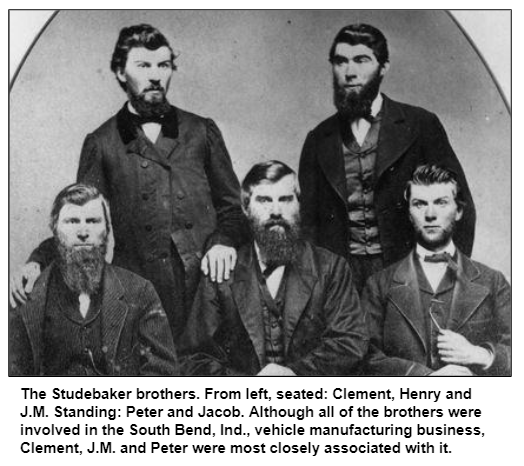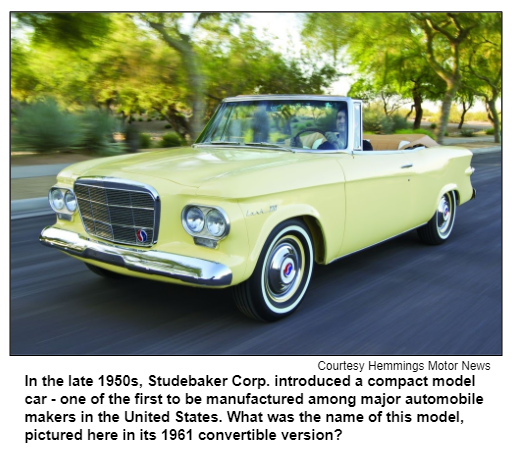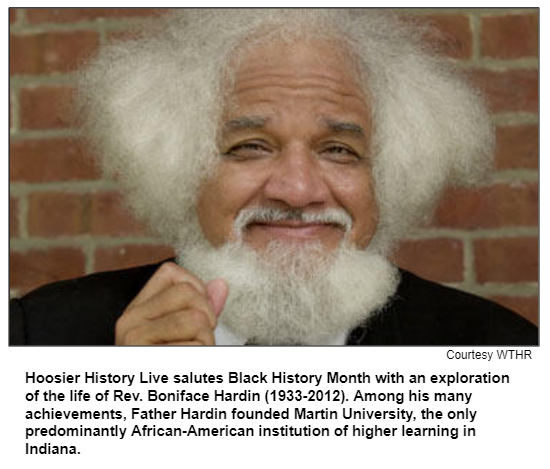
Saturdays, noon to 1 p.m. ET on WICR 88.7 FM.
Or stream audio live from anywhere on WICR Online!
You can listen to recent shows by clicking the podcast links below, or check out our extensive archive of past shows available as podcasts.
February 1, 2020
Studebakers: the brothers, the cars and the legacy

It all began in 1852 when the two oldest of five Studebaker brothers - Henry and Clement - opened a blacksmith shop, pursuing a trade they had been taught by their father. By the 1880s, Studebaker was the largest maker of vehicles - wagons, carriages and sleds, at that point - in the world.
Then came the heyday of auto production, with models like the Commander, the President, the moderately-priced Erskine and the luxurious Pierce-Arrow during the 1920s; the Land Cruiser in the 1930s; Champion Regal coupes in the 1950s; and the Avanti and the Daytona during the 1960s.
Although the final Studebaker car to be assembled in South Bend rolled off the production line in 1963, thousands of aficionados around the world continue to drive them.
Among the most popular destinations for visitors to South Bend is the three-story Studebaker National Museum, where galleries include exhibits of U.S. presidential carriages. Among the crown jewels displayed at the Studebaker museum: the Barouch carriage that transported the Lincolns to Ford's Theatre on the the night of the president's assassination in 1865.
For a motoring excursion through a broad landscape of Studebaker history, our two guests will be:
Andy Beckman of South Bend, the archivist for the Studebaker National Museum and past president of the Society of Automotive Historians. The museum, which has 55,000 square feet and galleries of vintage cars and wagons, also houses the archives of the Studebaker Corp. and other South Bend businesses dating to the 1850s.
- Bob Palma of Brownsburg, who writes Studebaker columns for auto collector publications, including Hemmings Classic Car magazine; he also serves as the technical editor for the Studebaker Drivers Club's magazine, Turning Wheels. The owner of a fleet of four Astra white 1964 Daytona models (the last model year of South Bend production), Bob is retired from a career that included teaching auto mechanics at Arsenal Tech High School and editing industrial arts textbooks. During the mid-1950s, his father co-owned a Studebaker dealership.
Family connections have been part of the Studebaker heritage since the beginning. The fortunes of the wagon-making business are said to have been jump-started when John Mohler (J.M.) Studebaker, the third of the five brothers, returned from California to invest in his siblings' company. J.M. (1833-1917) had become wealthy by selling wheelbarrows to miners during the Gold Rush.
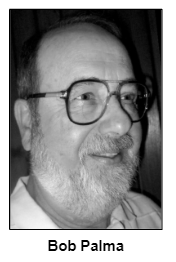
During World War II, Studebaker manufactured trucks and other vehicles used by the military. After the war, the company returned to making popular cars for middle-class Americans; our guest Bob Palma notes their 1947 models were touted with the slogan "first by far with a postwar car."
Other history facts:
- Perhaps the most famous Studebaker models were the "bullet-nosed" cars of the early 1950s. Bullet-nosed Champions, Commanders and Land Cruisers were manufactured then.
- Although Studebaker was based in South Bend, the Hoosier city wasn't the only site of its plants. In fact, a factory in Hamilton, Ontario, Canada, continued to build cars for a few years after assembly operations in South Bend closed in 1963. During our show, guest Bob Palma will explain how he and other enthusiasts obtain replacement parts for the cherished Studebakers that they continue to drive.
- Studebaker cars competed in the Indianapolis 500 during the early 1930s. For the 1962 race, the newly introduced Daytona convertible was the pace car.
Roadtrip: Culbertson Mansion in New Albany
Guest Roadtripper Kisha Tandy, Curator of Social History at the Indiana State Museum, suggests a visit to southern Indiana to visit the Culbertson Mansion in New Albany.
As Kisha tells us, the Culbertson Mansion was built in 1867 by William S. Culbertson, who had worked his way up from a lowly clerk in an Albany dry-goods store to own an investment company worth millions. He was the richest man in Indiana at the time of his death in 1892.
The opulence of the Culbertson Mansion reflects the wealth of the man who built it: hand-painted ceilings, a carved staircase, marble fireplaces and elaborate plasterwork are among the details that delight modern-day visitors. Size alone is an impressive feature: The Second-Empire style mansion contains 25 rooms that encompass more than 20,000 square feet.
But Kisha assures us that this Roadtrip isn't just about the architectural bling: as an official State Historic Site, the Culbertson Mansion seeks to educate visitors about the lifestyle of the Victorian-era moneyed class, as well as that of the servant staff who were responsible for maintaining the affluent household.
Sounds like a bit of Downton Abbey right here in Indiana! Be sure to tune with Kisha for this dramatic Roadtrip!
History Mystery
In 1959, Studebaker Corp. introduced a compact model car. According to our guest Bob Palma, Studebaker's compact model beat the "Big Three" automakers - General Motors, Ford and Chrysler - to the growing small-car market.
After the South Bend plant stopped making cars in 1963, the compact model continued to be built for a few years at Studebaker's smaller assembly plant in Hamilton, Ontario, Canada.
Question: What was the name of Studebaker's compact model car that debuted in 1959?
The call-in number is (317) 788-3314. Please do not call into the show until you hear Nelson pose the question on the air, and please do not try to win the prize if you have won any other prize on WICR during the last two months. You must be willing to give your name and address to our engineer and be willing to be placed on the air.
The prizes this week are two tickets to the Indiana Medical History Museum, courtesy of the Indiana Medical History Museum, and a gift certificate to Story Inn in Brown County, courtesy of Story Inn.
Nelson Price, host and historian
Molly Head, producer/general manager, (317) 927-9101
Michael Armbruster, associate producer
Cheryl Lamb, administrative manager
Richard Sullivan, senior tech consultant
Pam Fraizer, graphic designer
Garry Chilluffo, consultant
Please tell our sponsors that you appreciate their support!

 For organizational sponsorship, which includes logos, links, and voiced credits in the show and in podcasts, contact producer Molly Head at (317) 927-9101 or email her at molly@hoosierhistorylive.org. Our podcast listens are increasing at a rate of 17% a month!
For organizational sponsorship, which includes logos, links, and voiced credits in the show and in podcasts, contact producer Molly Head at (317) 927-9101 or email her at molly@hoosierhistorylive.org. Our podcast listens are increasing at a rate of 17% a month!
Acknowledgments to Visit Indy, Fraizer Designs, WICR-FM, Henri Pensis, Aaron Duvall, Chloe Tyson, and many other individuals and organizations.
Thank you!
We'd like to thank the following recent, new and renewal contributors whose donations help make this show possible!
- Bruce and Julie Buchanan
- David Willkie
- Coby Palmer in memory of Gary BraVard
- Tim Harmon
- Jane Simon Ammeson
- Kathleen Angelone
- Chuck and Karen Bragg
- "Jingle Bell Rock" in memory of Bobby Helms
- Theresa and Dave Berghoff
- Dr. William McNiece
- Ann Frick
- Margaret Smith
- Carl and Kathleen Widland
February 8, 2020 - coming up
The life and impact of Rev. Boniface Hardin
With what was often described as a "cloud of white hair" and a distinctive beard, Rev. Boniface Hardin would have drawn attention even if he had not emerged during the 1960s as one of the most prominent civil rights activists in Indianapolis.
As Hoosier History Live salutes Black History Month, we will explore the impact of Father Hardin (1933-2012), the founder of Martin University, the only predominantly African-American institution of higher learning in Indiana. He was among the first wave of black students to attend St. Meinrad Seminary in southern Indiana during the 1940s and '50s; when Father Hardin was ordained in 1959, he was one of only 88 black Catholic priests in the country.
The nearly 50 years he was based in Indianapolis were eventful, to say the least.
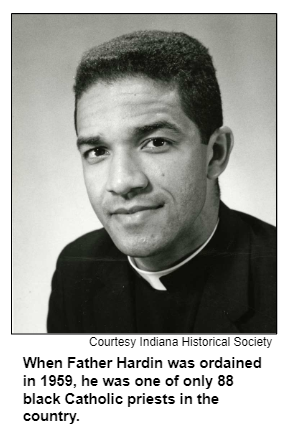
In addition to Father Hardin's unflagging advocacy on behalf of disenfranchised people - and his crusade to provide new educational opportunities - he was well known in later years for his public re-enactments of one of his role models: 19th-century abolitionist Frederick Douglass, to whom he bore a remarkable physical resemblance.
To share insights about Father Hardin, who had a soft voice but a compelling, folksy speaking style, three guests will join Nelson in studio:
- Nancy Chism, the author of a new biography of Father Hardin, Pickin' Cotton on the Way to Church (Indiana Historical Society Press). Nancy, who retired as associate vice chancellor of IUPUI, chairs Martin University's board of trustees.
- Joseph Smith Sr., a retired attorney and former parishioner at Holy Angels. His family had a decades-long friendship with Father Hardin.
- And Clete Ladd, who was mentored as a teenager by the Catholic priest. After Father Hardin urged him to enroll at Martin University, Clete eventually became a principal at Indianapolis-area schools.
Father Hardin was born and grew up in Kentucky. He came to Indiana, as our guest Nancy Chism reports in her biography, after he was "excluded from the seminaries in Kentucky because of his race."
Father Hardin's impact on his adopted home state resulted in honors such as being named a Living Legend by the Indiana Historical Society in 2002.
© 2020 Hoosier History Live. All rights reserved.
|
